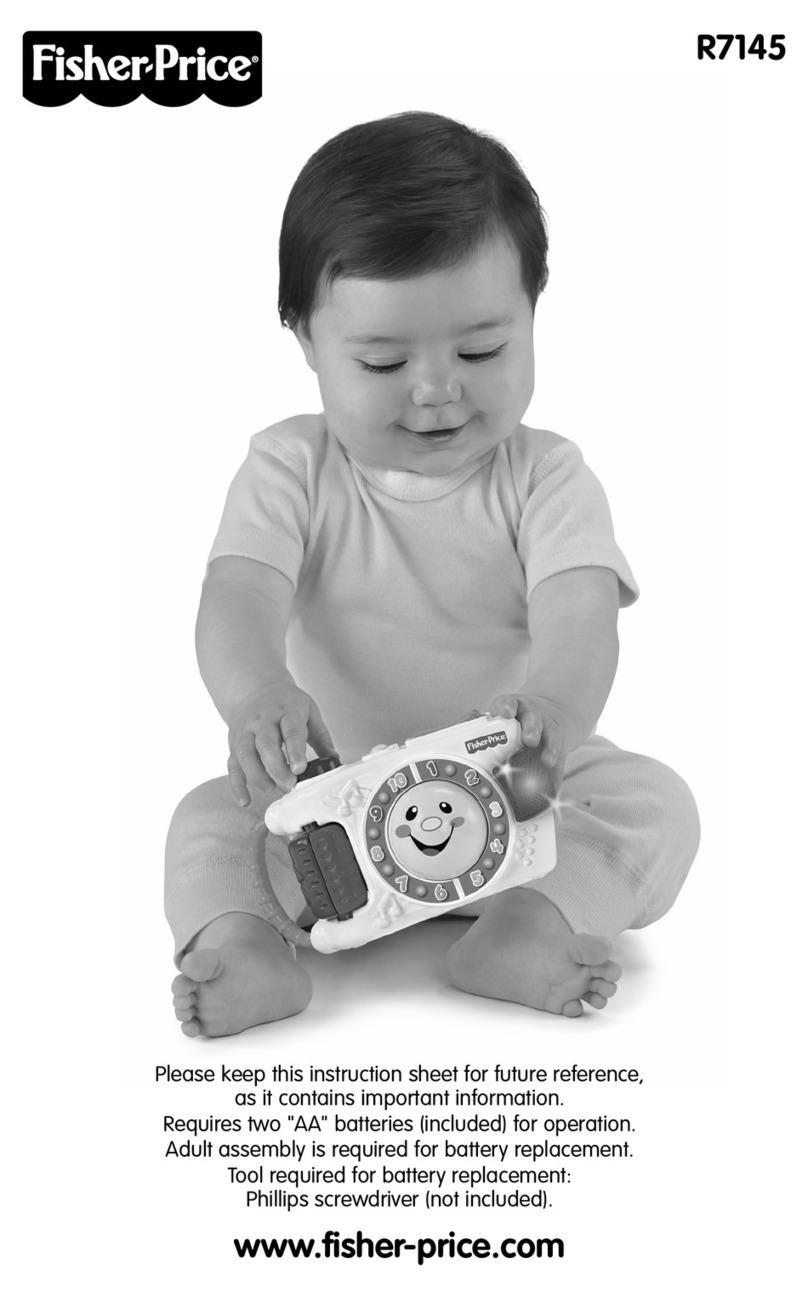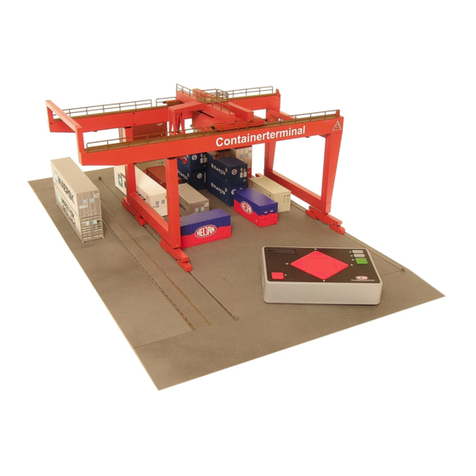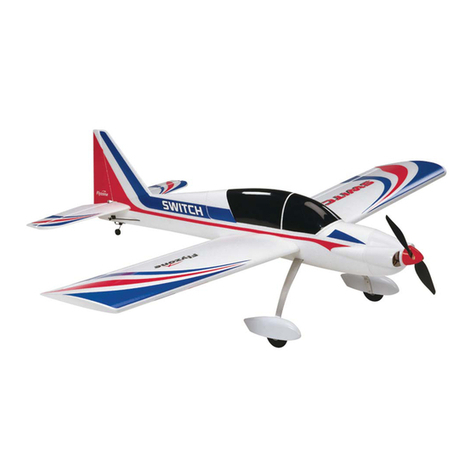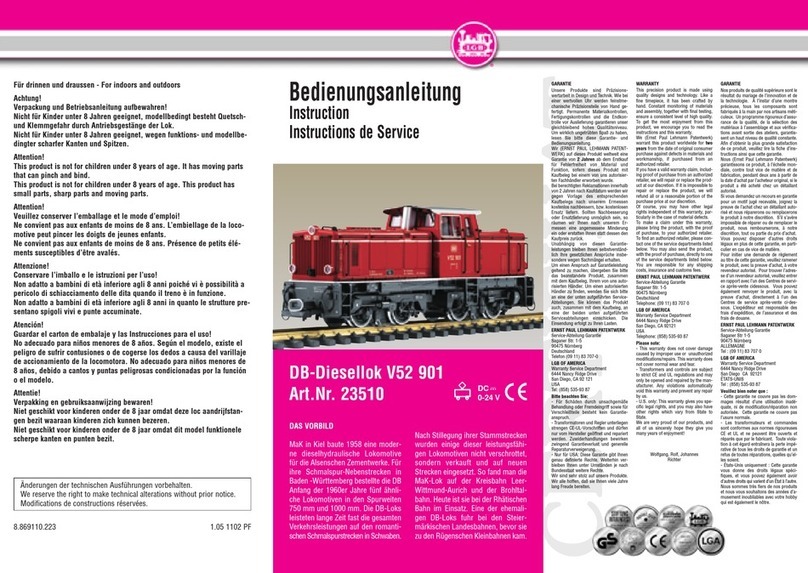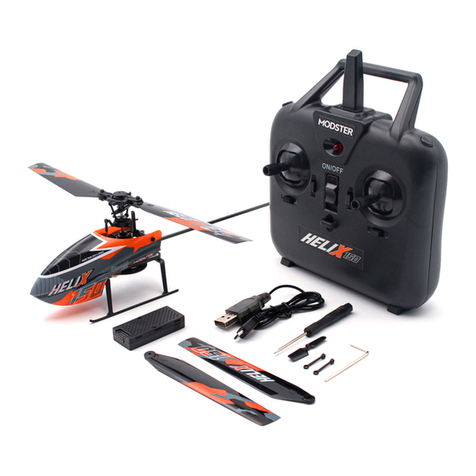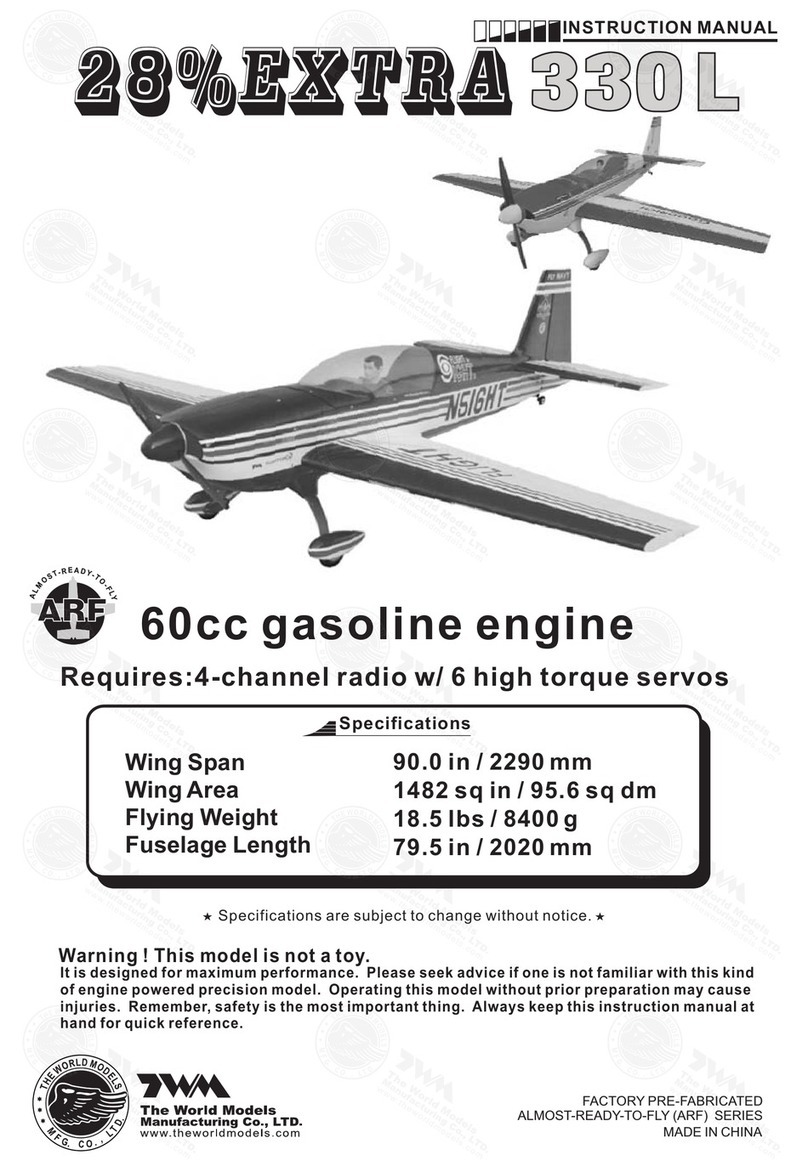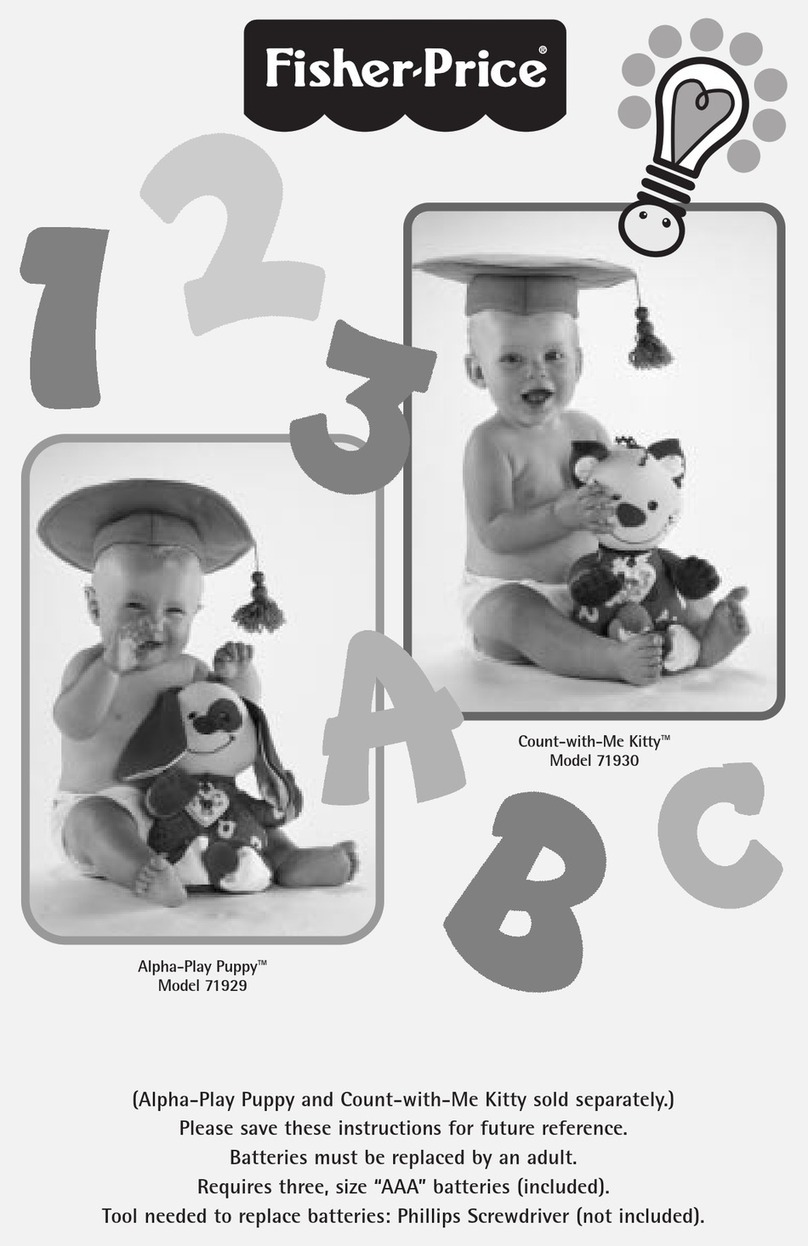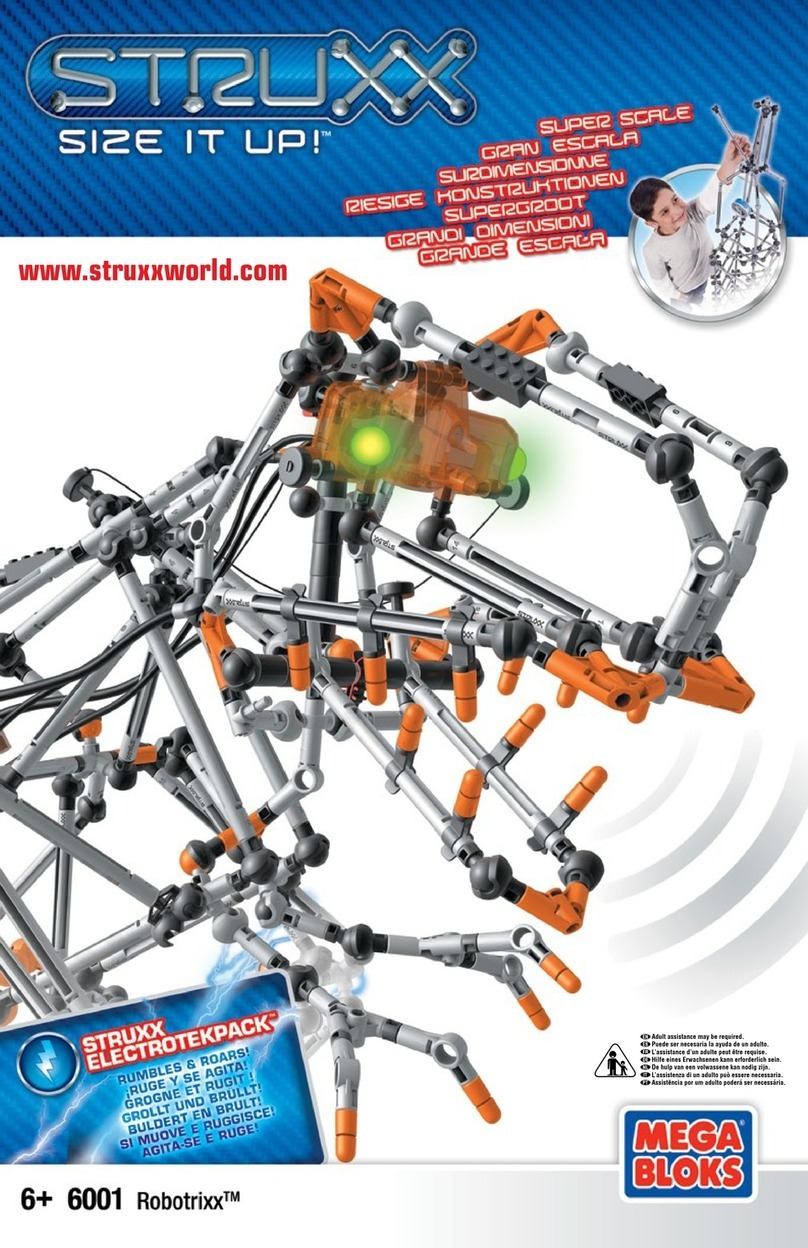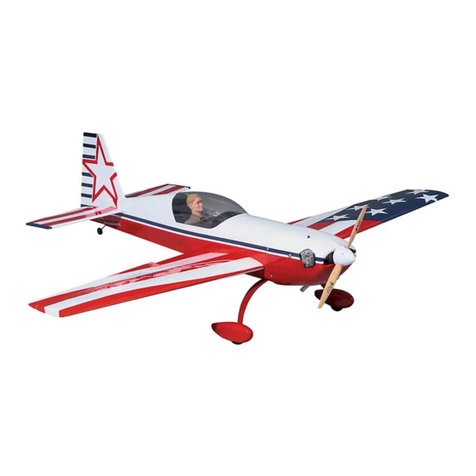electrifly SR22Turbo User manual

Wingspan: 50.5 in [1285mm]
Wing Area: 305 in2 [19.7 dm2]
Wing Loading: 19-23 oz/ft2 [58-70 g/dm2]
Length: 36 in [915mm]
Weight: 2.5-3 lb [1130-1360 g]
Radio: 4-channel, 4-nano servos
Motor: .10 (35-30-1250) Brushless
Outrunner
INSTRUCTION
MANUAL
Champaign, Illinois
(217) 398-8970, Ext 5
airsuppor[email protected]
© 2010 Hobbico®, Inc. GPMA1166 Mnl
READ THROUGH THIS MANUAL BEFORE STARTING CONSTRUCTION. IT CONTAINS IMPORTANT
INSTRUCTIONS AND WARNINGS CONCERNING THE ASSEMBLY AND USE OF THIS MODEL.
WARRANTY
SPECIFICATIONS
Great Planes®Model Manufacturing Co. guarantees this kit to
be free from defects in both material and workmanship at the
date of purchase. This warranty does not cover any component
parts damaged by use or modification. In no case shall Great
Planes’ liability exceed the original cost of the purchased kit.
Further, Great Planes reserves the right to change or modify this
warranty without notice.
In that Great Planes has no control over the final assembly or
material used for final assembly, no liability shall be assumed nor
accepted for any damage resulting from the use by the user of
the final user-assembled product. By the act of using the
user-assembled product, the user accepts all resulting liability.
If the buyer is not prepared to accept the liability associated
with the use of this product, the buyer is advised to return
this kit immediately in new and unused condition to the
place of purchase.
To make a warranty claim send the defective part or item to
Hobby Services at the address below:
Hobby Services
3002 N. Apollo Dr. Suite 1
Champaign IL 61822 USA
Include a letter stating your name, return shipping address, as
much contact information as possible (daytime telephone
number, fax number, e-mail address), a detailed description of
the problem and a photocopy of the purchase receipt. Upon
receipt of the package the problem will be evaluated as quickly
as possible.
Wingspan
:
5
0.5 in
[
1285
mm
]
Wing Area
:
3
05
i
n
2
[
19.7 dm
2
]
Wing Loading
:
19
-
23
o
z
/
f
t
2
[
58
-7
0
g
/
d
m
2
]
L
engt
h:
3
6 in
[
915mm
]
W
eight
:
2.5-3 lb
[
113 0
-
1360
g
]
Radio
:
4-channel
,
4-nano servos
M
otor:
.
10 (35-30-1250) Brushles
s
O
utrunner
WARRANTY
SPECIFICATIONS
CIRRUS®is a registered trademark of Cirrus Design Corporation and is in no way affiliated with Hobbico, Inc.

2
TABLE OF CONTENTS
INTRODUCTION . . . . . . . . . . . . . . . . . . . . . . . . . . . . . . . .2
SAFETY PRECAUTIONS . . . . . . . . . . . . . . . . . . . . . . . . .2
DECISIONS YOU MUST MAKE. . . . . . . . . . . . . . . . . . . . .3
Radio Equipment . . . . . . . . . . . . . . . . . . . . . . . . . . . . .3
Motor Recommendation. . . . . . . . . . . . . . . . . . . . . . . .3
Propeller. . . . . . . . . . . . . . . . . . . . . . . . . . . . . . . . . . . .3
Batteries and Charger . . . . . . . . . . . . . . . . . . . . . . . . .3
Pilot . . . . . . . . . . . . . . . . . . . . . . . . . . . . . . . . . . . . . . .3
ADDITIONAL ITEMS REQUIRED . . . . . . . . . . . . . . . . . . .4
Adhesives and Building Supplies. . . . . . . . . . . . . . . . .4
Optional Supplies and Tools. . . . . . . . . . . . . . . . . . . . .4
Building Stand . . . . . . . . . . . . . . . . . . . . . . . . . . . . . . .4
IMPORTANT BUILDING NOTES. . . . . . . . . . . . . . . . . . . .4
KIT INSPECTION. . . . . . . . . . . . . . . . . . . . . . . . . . . . . . . .5
ORDERING REPLACEMENT PARTS . . . . . . . . . . . . . . . .5
KIT CONTENTS. . . . . . . . . . . . . . . . . . . . . . . . . . . . . . . . .5
BUILDING INSTRUCTIONS . . . . . . . . . . . . . . . . . . . . . . .6
Preparations. . . . . . . . . . . . . . . . . . . . . . . . . . . . . . . . .6
Assemble the Wing Panels . . . . . . . . . . . . . . . . . . . . .6
Install the Tail Section . . . . . . . . . . . . . . . . . . . . . . . . .9
Install the Nose Gear, Motor and ESC. . . . . . . . . . . .12
Finish the Model. . . . . . . . . . . . . . . . . . . . . . . . . . . . .14
APPLY THE DECALS . . . . . . . . . . . . . . . . . . . . . . . . . . .16
GET THE MODEL READY TO FLY . . . . . . . . . . . . . . . . . 17
Check the Control Directions . . . . . . . . . . . . . . . . . . . 17
Set the Control Throws. . . . . . . . . . . . . . . . . . . . . . . .17
Balance the Model (C.G.). . . . . . . . . . . . . . . . . . . . . .18
Balance the Model Laterally. . . . . . . . . . . . . . . . . . . .19
PREFLIGHT . . . . . . . . . . . . . . . . . . . . . . . . . . . . . . . . . . .19
Identify Your Model. . . . . . . . . . . . . . . . . . . . . . . . . . .19
Charge the Batteries . . . . . . . . . . . . . . . . . . . . . . . . .19
Balance Propellers. . . . . . . . . . . . . . . . . . . . . . . . . . .19
Range Check . . . . . . . . . . . . . . . . . . . . . . . . . . . . . . .19
MOTOR SAFETY PRECAUTIONS . . . . . . . . . . . . . . . . .20
LITHIUM BATTERY HANDLING AND USAGE . . . . . . . .20
AMA SAFETY CODE. . . . . . . . . . . . . . . . . . . . . . . . . . . .20
CHECK LIST . . . . . . . . . . . . . . . . . . . . . . . . . . . . . . . . . . 21
FLYING. . . . . . . . . . . . . . . . . . . . . . . . . . . . . . . . . . . . . . . 21
Takeoff . . . . . . . . . . . . . . . . . . . . . . . . . . . . . . . . . . . .21
Flight . . . . . . . . . . . . . . . . . . . . . . . . . . . . . . . . . . . . .22
Landing . . . . . . . . . . . . . . . . . . . . . . . . . . . . . . . . . . .22
INTRODUCTION
Congratulations on your purchase of the Great Planes
ElectriFly Cirrus SR22 ARF! With only an evening or two of
final assembly, you will be rewarded with a beautiful scale
model that flies with inexpensive radio components and can
fit in the backseat of a car without removing the wings. The
wings can be removed for storage by simply unscrewing the
knurled wing bolts and sliding the panels off of the lightweight
carbon wing tube. Battery changes are a snap with the self-
aligning magnetic hatch. A fiberglass fuselage and canopy
hatch ensure a smooth appearance that looks great in the
pits and in the air. A cockpit interior, which only requires the
addition of a pilot(s) of your choice, finishes off the realism.
For the latest technical updates or manual corrections to
the Cirrus SR22 ARF visit the Great Planes web site at
www.greatplanes.com. Open the “Airplanes” link, then
select the Cirrus SR22 ARF. If there is new technical
information or changes to this model a “tech notice” box will
appear in the upper left corner of the page.
AMA
If you are not already a member of the AMA, please join!
The AMA is the governing body of model aviation and
membership provides liability insurance coverage, protects
modelers’ rights and interests and is required to fly at most
R/C sites.
ACADEMY OF MODEL AERONAUTICS
5151 East Memorial Drive
Muncie, IN 47302-9252
Tele. (800) 435-9262
Fax (765) 741-0057
Or via the Internet at:
www.modelaircraft.org
IMPORTANT!!!
Two of the most important things you can do to preserve the
radio controlled aircraft hobby are to avoid flying near full-
scale aircraft and avoid flying near or over groups of people.
PROTECT YOUR MODEL, YOURSELF
& OTHERS… FOLLOW THESE
IMPORTANT SAFETY PRECAUTIONS
1. Your Cirrus SR22 ARF should not be considered a toy, but
rather a sophisticated, working model that functions very
much like a full-size airplane. Because of its performance
capabilities, the Cirrus SR22, if not assembled and operated
correctly, could possibly cause injury to yourself or spectators
and damage to property.
2. You must assemble the model according to the
instructions. Do not alter or modify the model, as doing so
may result in an unsafe or unflyable model. In a few cases
the instructions may differ slightly from the photos. In those
instances the written instructions should be considered
as correct.
3. You must take time to build straight, true and strong.
4. You must use an R/C radio system that is in good condition,
a correctly sized motor, and other components as specified
in this instruction manual. All components must be correctly
installed so that the model operates correctly on the ground
and in the air.You must check the operation of the model and
all components before every flight.
5. If you are not an experienced pilot or have not flown
this type of model before, we recommend that you get
the assistance of an experienced pilot in your R/C club for

3
your first flights. If you’re not a member of a club, your local
hobby shop has information about clubs in your area whose
membership includes experienced pilots.
6. While this kit has been flight tested to exceed normal use,
if the plane will be used for extremely high stress flying, such
as racing, or if a motor larger than one in the recommended
range is used, the modeler is responsible for taking steps to
reinforce the high stress points and/or substituting hardware
more suitable for the increased stress.
7. WARNING: The fuselage, wheel pants, and canopy hatch
included in this kit are made of fiberglass, the fibers of which
may cause eye, skin and respiratory tract irritation. Never
blow into a part to remove fiberglass dust, as the dust will
blow back into your eyes. Always wear safety goggles, a
particle mask and rubber gloves when grinding, drilling and
sanding fiberglass parts. Vacuum the parts and the work
area thoroughly after working with fiberglass parts.
We, as the kit manufacturer, provide you with a top quality,
thoroughly tested kit and instructions, but ultimately the
quality and flyability of your finished model depends
on how you build it; therefore, we cannot in any way
guarantee the performance of your completed model,
and no representations are expressed or implied as to the
performance or safety of your completed model.
Remember:Take your time and follow the instructions to
end up with a well-built model that is straight and true.
DECISIONS YOU MUST MAKE
This is a partial list of items required to finish the Cirrus SR22
ARF that may require planning or decision making before
starting to build. Order numbers are provided in parentheses.
Radio Equipment
The Cirrus SR22 ARF requires a minimum 4-channel radio
system with four nano servos such as the ElectriFly ES-50
nano servo. In addition, two 12" [305mm] servo extensions
and a dual servo extension are required for the aileron servos.
❏
Great Planes ElectriFly ES50 Nano Servo J (GPMM1210)
❏
Hobbico®Extension 12" [152mm] Futaba J (HCAM2100)
❏
Futaba®Dual Servo Extension 6" J (FUTM4130)
Motor Recommendation
The recommended motor for the Cirrus SR22 ARF is a
RimFire™.10 (35-30-1250) brushless outrunner motor.
❏
Great Planes RimFire .10 (35-30-1250) Outrunner
Brushless (GPMG4595)
If using the recommended brushless motor, a 35A brushless
ESC is required:
❏
Great Planes Silver Series 35A Brushless ESC 5V/2A
(GPMM1830)
Propeller
If you are installing the recommended RimFire brushless
motor, we suggest a 10x7E APC propeller (APCQ4123).
Batteries and Charger
One 1500-3350mAh 11.1V Lithium Polymer battery pack
is recommended. Using a 2200mAh 11.1V LiPo, our SR22
balanced at the recommended C.G. without the need for
additional ballast.
❏
Great Planes ElectriFly LiPo 3S 11.1V 1500mAh 25C
(GPMP0511)
❏
Great Planes ElectriFly LiPo 3S 11.1V 2200mAh 25C
(GPMP0520)
❏
FlightPower®EON-X™Lite LiPo 3S 11.1V 2500mAh 25C
(FPWP4238)
❏
Great Planes ElectriFly LiPo 3S 11.1V 3350mAh 25C
(GPMP0541)
A cell balancer is required for the LiPo battery packs listed
above:
❏
Great Planes ElectriFly Equinox™LiPo Cell Balancer 1-5
(GPMM3160)
A suitable charger is also required. The Great Planes
PolyCharge4™is designed for LiPo packs only. However, it
is able to charge four LiPo packs simultaneously. The Great
Planes Triton2™charger will only charge one pack at a time,
but is capable of charging NiCd, NiMH, LiPo, and Pb acid
batteries. Order numbers for both are provided below:
❏
Great Planes PolyCharge4 DC Only 4 Output LiPo
Charger (GPMM3015) OR
❏
Great Planes ElectriFly Triton2 DC Comp Peak Charger
(GPMM3153)
Pilot
If you wish to use the same pilot that is shown in the building
instructions, purchase Williams Brothers 1/8 Pilot Bust Kit
Sportsman (WBRQ1130). This pilot figure requires finish
sanding and painting, and some additional modification of
the pilot figure is described in the building instructions.

4
ADDITIONAL ITEMS REQUIRED
Adhesives and Building Supplies
This is the list of Adhesives and Building Supplies that are
required to finish the Cirrus SR22 ARF:
❏
1/2 oz. [15g] Thin Pro™CA (GPMR6001)
❏
1/2 oz. [15g] Thick Pro CA- (GPMR6013)
❏
Threadlocker thread locking cement (GPMR6060)
❏
Drill bits: 1/16" [1.6mm], 5/64" [2mm]
❏
Small metal file or rotary tool
❏
Revell®#1 Light Duty Aluminum Handle Knife w/Blade
(RMXR6901)
❏
Revell #11 Light Duty Blades (5) (RMXR6930)
❏
Medium T-pins (100, HCAR5150)
❏
Top Flite®MonoKote®sealing iron (TOPR2100)
❏
Top Flite Hot Sock™iron cover (TOPR2175)
❏
220 grit sandpaper
❏
Panel Line Pen (TOPQ2510)
Optional Supplies and Tools
Here is a list of optional tools that will help you build the
Cirrus SR22 ARF:
❏
1/2 oz. [15g] Medium Pro CA+ (GPMR6007)
❏
2 oz. [57g] spray CA activator (GPMR6035)
❏
4 oz. [113g] aerosol CA activator (GPMR6034)
❏
CA applicator tips (HCAR3780)
❏
CA debonder (GPMR6039)
❏
Pro 6-minute epoxy (GPMR6045)
❏
Pro 30-minute epoxy (GPMR6047)
❏
Epoxy brushes 6, (GPMR8060)
❏
Mixing sticks (GPMR8055)
❏
Mixing cups (GPMR8056)
❏
Pliers with wire cutter (HCAR0630)
❏
Rotary tool reinforced cut-off wheel (GPMR8020)
❏
Hobby Heat™micro torch II (HCAR0755)
❏
Precision Magnetic Prop Balancer (TOPQ5700)
❏
AccuThrow™Deflection Gauge (GPMR2405)
❏
CG Machine™(GPMR2400)
❏
Hobbico Flexible 18" Ruler Stainless Steel (HCAR0460)
❏
Top Flite MonoKote heat gun (TOPR2000)
❏
Hobbico Pin Vise 1/16 Collet w/6 Bits (HCAR0696)
❏
Great Planes Heat Shrink Tubing 3/8x3" (3) (GPMM1060)
❏
Woodland Scenics Low Temp Foam Glue Gun
(WOOU1445)
❏
Denatured alcohol (for epoxy clean up)
Building Stand
A building stand or cradle comes in handy during the build.
We use the Robart Super Stand II (ROBP1402) for all our
projects in R&D, and it can be seen in pictures throughout
this manual.
IMPORTANT BUILDING NOTES
• When you see the term test fit in the instructions, it means
that you should first position the part on the assembly without
using any glue, then slightly modify or custom fit the part as
necessary for the best fit.
• Whenever the term “glue” is written, you should rely upon
your experience to decide what type of glue to use. When
a specific type of adhesive works best for that step, the
instructions will make a recommendation.
• Photos and sketches are placed before the step they refer
to. Frequently you can study photos in following steps to get
another view of the same parts.
• The Cirrus SR22 is factory-covered with Top Flite Jet White
MonoKote film (TOPQ0204). Should repairs ever be required,
MonoKote can be patched with additional MonoKote
purchased separately. MonoKote is packaged in six-foot rolls,
but some hobby shops also sell it by the foot. If only a small
piece of MonoKote is needed for a minor patch, perhaps a
fellow modeler would give you some. MonoKote is applied
with a model airplane covering iron, but in an emergency a
regular iron could be used. A roll of MonoKote includes full
instructions for application.
• The stabilizer and wing incidences and engine thrust angles
have been factory-built into this model. However, some
technically-minded modelers may wish to check these
measurements anyway. To view this information visit the web
site at www.greatplanes.com and click on “Technical Data.”
Due to manufacturing tolerances which will have little or no
effect on the way your model will fly, please expect slight
deviations between your model and the published values.

5
KIT CONTENTS
1. Fuselage, canopy hatch
2. Wing
3. Horizontal stabilizer
(stab) with elevators
4. Rudder
5. Cockpit interior
6. Main landing gear
7. Main gear wheel pants
8. Main wheels
9. Nose gear fairing
10. Nose gear
11. Nose wheel
12. Nose wheel pant
13. Spinner
14. Wing tube
KIT INSPECTION
Before starting to build, inspect the parts to make sure they
are of acceptable quality. If any parts are missing or are not of
acceptable quality, or if you need assistance with assembly,
contact Product Support. When reporting defective or
missing parts, use the part names exactly as they are written
in the Kit Contents list.
Great Planes Product Support
3002 N. Apollo Drive, Suite 1
Champaign, IL 61822
Telephone: (217) 398-8970, ext. 5
Fax: (217) 398-7721
E-mail: [email protected]
ORDERING REPLACEMENT PARTS
Replacement parts for the Great Planes Cirrus SR22 ARF
are available using the order numbers in the Replacement
Parts List that follows.The fastest, most economical service
can be provided by your hobby dealer or mail-order company.
To locate a hobby dealer, visit the Great Planes web site
at www.greatplanes.com. Choose “Where to Buy” at the
bottom of the menu on the left side of the page. Follow the
instructions provided on the page to locate a U.S., Canadian
or International dealer.
Parts may also be ordered directly from Hobby Services
by calling (217) 398-0007, or fax at (217) 398-7721, but full
retail prices and shipping and handling charges will apply.
Illinois and Nevada residents will also be charged sales tax.
If ordering via fax, include a Visa®or MasterCard®number
and expiration date for payment.
Mail parts orders and payments by personal check to:
Hobby Services
3002 N. Apollo Drive, Suite 1
Champaign, IL 61822
Be certain to specify the order number exactly as listed in
the Replacement Parts List. Payment by credit card or
personal check only; no C.O.D.
If additional assistance is required for any reason, contact
Product Support by telephone at (217) 398-8970, or by
Order No. Description
NOTE
REPLACEMENT PARTS LIST
Full-size plans are not available.
You can download a copy of this
manual at www.greatplanes.com.
GPMA4035
GPMA4036
GPMA4037
GPMA4038
GPMA4039
GPMA4040
GPMA4041
GPMA4042
GPMA4043
GPMA4044
GPMA4045
FUSELAGE
WING
TAIL SURFACES
HATCH
WHEELPANTS
NOSE GEAR FAIRING
MAIN GEAR SET
NOSE GEAR
DECALS
WING JOINER ROD
SPINNER

6
BUILDING INSTRUCTIONS
Preparations
❏ 1. If you have not done so already, remove the major
parts of the kit from the box and inspect for damage. If any
parts are damaged or missing, contact Product Support at
the address or telephone number listed in the “Kit Inspection”
section on page 5.
❏ 2. Carefully remove the tape and separate all the control
surfaces. Use a covering iron with a covering sock on high
heat to tighten the covering if necessary. Apply pressure over
sheeted areas to thoroughly bond the covering to the wood.
Assemble the Wing Panels
❏ 1. Attach a 12" [305mm] servo extension to each aileron
servo. Secure the connections using tape, heat shrink tubing
(not included) or special clips designed for that purpose.
❏ 2. Locate the strings taped inside the aileron servo bays
and tie the ends of the strings to the servo extensions. Use
the string to pull the servo leads through the wing ribs.
❏ 3. Install the rubber grommets and eyelets included with
the servos. Position the servos in the aileron servo bays in
the orientation shown. Drill 1/16" [1.6mm] holes through
the servo mounting tabs. Thread a servo mounting screw
(included with the servos) into each hole and back it out.
Apply a drop of thin CA to each hole to harden the wood.
When the glue has dried, install the servos using the screws
included with the servos.

7
❏ 4. Install a screw lock pushrod connector into the outer
hole of the long servo arm as shown with a nylon screw
lock retainer. Loosely thread a 2x4mm machine screw into
the connector. Center the servos with your radio system and
install the servo arm onto the servo parallel to the aileron
hinge line as shown with the connector toward the wing
tip. Be sure to reinstall the servo arm screw into the servo.
Repeat this step for the other aileron servo.
Hinge Line Hinge Line
CORRECT INCORRECT
Hi
❏ 5. Connect the Z-bend end from a 90mm aileron pushrod
into the second outer hole of a control horn. Insert the
other end into the screw lock pushrod connector. Align the
pushrod perpendicular to the hinge line and align the holes
in the control horns directly over the aileron hinge line. Mark
the location of the control horn mounting holes. Repeat this
step for the other aileron servo.
❏ 6. Drill 5/64" [2mm] holes at the marks you made through
the ailerons. Apply a couple drops of thin CA glue to each
hole to harden the wood surrounding the holes. When the
glue has dried, install the control horns onto the ailerons
using four 2x16mm machine screws and control horn
backplates. The ends of the screws can be cut off beyond
the control horns.
❏ 7. Position the aileron in the neutral position and tighten
the screw in the screw lock pushrod connector against the
pushrod with threadlocking compound. The excess pushrod
beyond the pushrod connector can be cut off.
❏ 8. Use medium or thick CA to glue the carbon anti-rotation
pins into the wing root ribs. The pins should protrude beyond
the ribs approximately 5/16" [8mm].

8
❏ 9. Install the axles onto the landing gear legs using the
included landing gear nuts and threadlocking compound.
❏ 10. Slide a 4mm wheel collar onto each axle followed
by a main wheel and another 4mm wheel collar. Mark the
location of the screw holes in the wheel collars onto the
axles. Remove the wheel collars and wheels and use a file
or rotary tool to grind flat spots onto the axles at the marks
you made.
❏ 11. Install the wheel collars and main wheels onto the
axles. Secure the collars onto the axles with 3mm set screws
and threadlocking compound. Be sure that the wheels rotate
freely. Oil them if necessary.
❏ 12. Thread a 2x6mm self-tapping screw into each hole in
the wheel pants and back it out. Apply a drop of thin CA to
each hole and allow the glue to dry. Install the wheel pants
onto the landing gear with four 2x6mm self-tapping screws.
❏ 13. Bolt the landing gear legs to the wing panels using
six 3x10mm machine screws and threadlocking compound.

9
Install the Tail Section
❏ 1. Insert the carbon wing tube into the outer wing tube
in the fuselage and center it left and right. Slide the wing
panels onto the tube and tighten them down using the
included wing bolts.
❏ 2.Lightly sand the inside of the stabilizer slot in the fuselage
with 220 grit sandpaper and clean it with denatured alcohol.
Temporarily install the horizontal stabilizer into the stab slot
and center it right and left. Stand back 5-6 ft [1.5–1.8m] and
view the model from behind. Confirm that the stab and wings
are parallel. If not, sand the slot as necessary until they are
parallel. A weight can also be placed on the high side to bring
the stab parallel with the wings.
❏ 3. Confirm that the stab is still centered left and right.
Measure from the wing tips to the stab tips and make those
distances equal. Use a felt-tip pen to trace around the
fuselage onto the stabilizer.
❏ 4. Carefully cut the covering 1/16" [1.6mm] inside the
lines you drew and remove the covering. Use a sharp hobby
knife and take care to only cut through the covering and not
into the wood beneath. Use denatured alcohol to wipe away
the lines you drew (or use CA debonder). See the following
Expert Tip for an alternative method for removing covering.

10
HOW TO CUT COVERING FROM BALSA
Use a soldering iron to cut the covering from the stab. The
tip of the soldering iron doesn’t have to be sharp, but a fine
tip does work best. Allow the iron to heat fully.
Use a straightedge to guide the soldering iron at a rate
that will just melt the covering and not burn into the wood.
The hotter the soldering iron, the faster it must travel to
melt a fine cut. Peel off the covering.
❏ 5. Before gluing the stab into position in the fuselage,
check the fit of the elevator joiner wire by inserting it into the
holes in the leading edge of the elevators. Lay the elevators
on a flat work surface and confirm that they both lay flat. If
not, remove the wire from the elevators and use pliers to
bend or “tweak” it until they do. Do not attempt to bend the
joiner wire while it is installed in the elevators!
❏ 6. Insert the elevator joiner wire into the aft end of the
stab slot. Insert the stab into the slot and center it left and
right. Measure from the wing tips to the stab tips and make
those distances equal. Confirm that the stab and wing are
still parallel. A weight can be added to one side of the stab
to make any small corrections. When satisfied, wick thin CA
along the edges where the stab meets the fuselage. When
the CA has dried, confirm that the stab is thoroughly glued
to the fuselage. Note: epoxy can also be used in this step.
DRILL A 5/64" [2mm] HOLE,
3/8" [9.5mm] DEEP, IN CENTER
OF HINGE SLOT
CUT THE COVERING
AWAY FROM THE SLOT
❏ 7. Drill a 5/64" [2mm] hole 3/8" [9.5mm] deep into the
center of each hinge slot in the elevator halves and stab.
Trim the covering away from each hinge slot to ensure that
the hinges will be properly glued in place.

11
❏ 8. Test fit the elevator halves onto the stab with CA hinges.
If necessary, enlarge the hinge slots with a hobby knife.
When satisfied with the fit, insert a CA hinge halfway into
each hinge slot in the stab. Push a pin through the middle
of each hinge to keep them centered. The elevator joiner
wire ends fit into the pre-drilled holes and slots at the LE
of the elevators. When satisfied, roughen the ends of the
elevator joiner wire with sandpaper and clean them with
denatured alcohol. Mix up a small amount of epoxy and coat
the ends of the joiner wire. Install the elevator halves onto
the stab with CA hinges, being sure that there are even gaps
between the stab tips and elevators on each side. Remove
the pins from the hinges. Apply six drops of thin CA to the
top and bottom of each hinge without using accelerator. After
the CA glue has hardened, confirm that the elevators are
secure by pulling on them and deflecting them up and down.
Wipe away any excess epoxy with denatured alcohol. The
CA hinges will hold the elevators in place while the epoxy on
the joiner wire cures.
❏ 9. Install the rudder to the fuselage in the same manner.
❏ 10. Use your radio system to center the elevator and rudder
servo. Install the servos into the fuselage as shown using the
hardware included with the servos. NOTE: Additional servo
bays are included aft of the ones shown in the photo. If you
plan to use a larger battery such as an 11.1V 3350mAh LiPo,
install your servos in the aft position to provide additional space
on the battery tray.
❏ 11. Install two screw-lock connectors in the outer holes
of the rudder servo arm and one in the outer hole of the
elevator servo arm. Loosely thread a 2x4mm machine screw
into each connector. Install the servo arms onto the servos
using the servo arm screw, being sure that the arms are
perpendicular with the servo case.

12
❏ 12. Insert the long pushrods into the rudder and elevator
outer pushrod tubes and through the screw lock connectors
on the servos. Hook a control horn to the Z-bend of the
elevator pushrod (use the outer hole in the control horn)
and, using the pushrod as a guide to position the control
horn, install the horn onto the underside of the left elevator
with 2x16mm machine screws. Install a control horn onto the
rudder in the same manner using the second outer hole in
the control horn.
❏ 13. Center the elevators and rudder. Tighten the screws
in the screw lock connectors against the pushrods. The
excess length of pushrod can be cut off 1/4" [6mm] beyond
the connectors.
Install the Nose Gear, Motor and ESC
❏ 1. Insert the nose gear wire through the nose wheel pant
followed by an aluminum spacer, nose wheel, and the other
aluminum spacer. Confirm that the wheel rotates freely. If
not, remove the wheel and lightly sand each side of the
wheel hub where it contacts the spacers. Oil the axle and
reinstall the wheel.
❏ 2. Thread a 2.5x8mm self-tapping washer head screw
into each hole in the nose wheel pant and back it out. Apply a
drop of thin CA to each hole and allow it to harden completely.
Secure the nose gear to the wheel pant with a nylon strap
and two 2.5x8mm self-tapping washer head screws.
❏ 3. Fit one half of the nose gear fairing to the nose gear
and carefully apply a thin bead of medium or thick CA glue

13
around its edge. Align the other half of the fairing over the
first and glue the edges of the parts together flush.
❏ 4. Glue the nose gear fairing to the wheel pant.
❏ 5. Insert the 3.5mm wheel collar into the nylon steering arm
and loosely thread a 3x8mm machine screw into the collar.
❏ 6. Fit the steering arm into the steering arm block so the
arm is on the right side of the fuselage. Insert the nose gear
wire through the hole on the underside of the fuselage and
up through the steering arm and block. Align the screw in
the steering arm with the flat spot on the wire and thoroughly
tighten the screw using threadlocking compound.
❏ 7. Insert the outer pushrod tube through the hole in the
plywood pushrod support. Insert the remaining pushrod
through the outer pushrod tube. Connect the Z-bend on the
pushrod to the outer hole in the steering arm. Insert the other
end through the screw lock connector on the rudder servo
arm (clip off some of the pushrod wire if necessary when
flexing the wire to fit into the connector). With the nose wheel
pointed straight and the rudder servo centered, tighten the
screw in the connector against the pushrod. Center the outer
pushrod tube fore and aft on the wire and fit the plywood
support into the notch on the battery tray.Thoroughly glue the
outer pushrod tube to the support and the support to the tray.

14
❏ 8. Remove the brass collar (if applicable) from your
brushless motor. Insert the motor against the inside face of
the firewall with the shaft protruding through the center hole.
Install the motor using four 3x8mm machine screws, four
3mm flat washers and threadlocking compound.
❏ 9. Apply a thin coat of epoxy to the inside of the fuselage
in the area where the ESC will be installed (with epoxy
brush in hand, also coat the center of the battery tray where
the battery and receiver will be installed). This will improve
the adhesion of the double-sided tape. When the epoxy
has completely cured, connect the ESC to the motor and
affix the ESC to the fuselage with a piece of the included
double-sided tape. Now would be a good time to use your
radio system to confirm the correct rotation of the motor. If
the motor is rotating in the wrong direction (it should rotate
counter-clockwise when viewed from the front), simply swap
two of the three motor wire leads. Be sure to neatly bundle
the excess motor lead wire out of the way of the steering arm.
Finish the Model
❏ 1. Cut a piece of the included self-adhesive hook and
loop material and use it to secure your receiver to the battery
tray just in front of the tail servos. Connect your servos to the
receiver. Neatly bundle the excess servo lead wires out of
the way of the tail servos.
❏ 2. In order to orient the receiver antennas as described in
the radio manual, we used scrap pieces of fuel tubing glued
to the inside of the fuselage (tape can also be used). If you
have an FM or PCM radio, route the receiver antenna out
the cutout on the bottom of the fuselage and tape it in place.

15
❏ 3. Cut pieces from the hook side of the included self-
adhesive hook and loop material and attach them to the
battery tray. Make a battery strap from the included non-
adhesive hook and loop material by overlapping the material
by approximately 1" [25mm]. Cut the strap to properly fit your
battery and insert it through the slots in the battery tray.
❏ 4. Apply the loop side to the battery and test fit it into the
fuselage.
❏ 5. Install the included prop adapter onto the motor shaft.
Be sure it is pressed on as far as it will fit onto the shaft.
❏ 6.Install the spinner backplate, propeller, prop washer, and
prop nut. Enlarge the slots in the spinner cone as necessary
to fit your propeller. When satisfied, install the spinner cone
to the spinner backplate using the included screws.
❏ 7. Apply the instrument panel decal to the cockpit interior.
❏ 8. If you plan to install a pilot figure, install him now
before gluing the cockpit interior to the canopy hatch. We
used a Williams Bros. 1/8 Sportsman pilot, stock number

16
WBRQ1130. To improve the appearance of the pilot when
installed in the Cirrus, we glued a 1/2" [13mm] thick piece of
scrap balsa to the bottom of the pilot and rough cut the block
to closely match the shape of the pilot. We then carefully
sanded the block to blend in with the pilot figure and used a
hobby knife and small wood file to continue the contours of
the shoulders and shirt seams onto the balsa block. Some
wood filler will fill the grain of the balsa and will allow the
paint to be applied smoothly. When satisfied, paint your pilot.
A 1/4" [6mm] thick scrap balsa will be required to raise the
height of the pilot above the arm rests when you glue him to
the pilot seat.
❏ 9.Glue the cockpit interior into the canopy hatch. You will
need to flex the forward end of the cockpit interior in order to
fit it into place. We recommend using hot glue or silicone to
glue the interior in place so if you wish to remove the interior
for access to the pilot, the glue joint can be easily broken.
Thick CA or epoxy would work as well. Use CA sparingly
without activator as there is a chance that CA fumes may
fog the windows.
❏ 10. You have now finished the assembly of the Cirrus
SR22 ARF!
APPLY THE DECALS
1. Be certain the model is clean and free from oily fingerprints
and dust. Prepare a dishpan or small bucket with a mixture
of liquid dish soap and warm water—about one teaspoon of
soap per gallon of water. Submerse the decal in the soap and
water and peel off the paper backing. Note: Even though the
decals have a “sticky-back” and are not the water transfer
type, submersing them in soap & water allows accurate
positioning and reduces air bubbles underneath.
2. Position decal on the model where desired. Holding the
decal down, use a paper towel to wipe most of the water
away.
3. Use a piece of soft balsa or something similar to squeegee
remaining water from under the decal. Apply the rest of the
decals the same way.

17
GET THE MODEL READY TO FLY
Check the Control Directions
1. Turn on the transmitter and receiver and center the trims.
If necessary, remove the servo arms from the servos and
reposition them so they are centered. Reinstall the screws
that hold on the servo arms.
2. With the transmitter and receiver still on, check all the
control surfaces to see if they are centered. If necessary,
adjust the pushrod positions in the screw lock connectors to
center the control surfaces.
FULL
THROTTLE
RUDDER
MOVES
RIGHT
ELEVATOR
MOVES DOWN
RIGHT AILERON
MOVES UP
LEFT AILERON
MOVES DOWN
4-CHANNEL RADIO SET UP
(STANDARD MODE 2)
3. Make certain that the control surfaces and the throttle
respond in the correct direction as shown in the diagram.
If any of the controls respond in the wrong direction, use
the servo reversing in the transmitter to reverse the servos
connected to those controls. Be certain the control surfaces
have remained centered. Adjust if necessary.
Set the Control Throws
❏ 1. Use a box or something similar to prop up the bottom
of the fuselage so the horizontal stabilizer and wing will be
level.
Measure the high rate elevator throw first…
❏ 2. Hold a ruler vertically on your workbench against the
widest part (front to back) of the trailing edge of the elevator.
Note the measurement on the ruler.
MOVE THE RULER FORWARD
❏ 3. Move the elevator up with your transmitter and move
the ruler forward so it will remain contacting the trailing edge.
The distance the elevator moves up from center is the “up”
elevator throw. Measure the down elevator throw the same
way.
❏ 4.Repeat this procedure for the remaining control surfaces.

18
Use a Great Planes AccuThrow (or a ruler) to accurately
measure and set the control throw of each control surface
as indicated in the chart that follows. If your radio does not
have dual rates, we recommend setting the throws at the
low rate setting.
NOTE: The throws are measured at the widest part of the
elevators, rudder and ailerons.
These are the recommended control surface throws:
ELEVATOR
HIGH RATE LOW RATE
1/4"
[6mm]
12°
Up
1/4"
[6mm]
12°
Down
1/8"
[3mm]
6°
1/4"
[6mm]
10°
Up
1/8"
[3mm]
6°
Down
RUDDER 7/16"
[11mm]
17°
Right
7/16"
[11mm]
17°
Left Right
1/4"
[6mm]
10°
Left
AILERONS 7/16"
[11mm]
17°
Up
7/16"
[11mm]
17°
Down
5/16"
[8mm]
12°
Up
5/16"
[8mm]
12°
Down
IMPORTANT: The Cirrus SR22 ARF has been extensively
flown and tested to arrive at the throws at which it flies
best. Flying your model at these throws will provide you
with the greatest chance for successful first flights. If, after
you have become accustomed to the way the Cirrus SR22
flies, you would like to change the throws to suit your taste,
that is fine. However, too much control throw could make
the model difficult to control, so remember, “more is not
always better.”
Balance the Model (C.G.)
More than any other factor, the C.G. (balance point) can
have the greatest effect on how a model flies, and may
determine whether or not your first flight will be successful.
If you value this model and wish to enjoy it for many flights,
DO NOT OVERLOOK THIS IMPORTANT PROCEDURE.
A model that is not properly balanced will be unstable and
possibly unflyable.
At this stage the model should be in ready-to-fly condition
with all of the systems in place including the brushless motor,
landing gear, the radio system and battery pack.
❏ 1. Use a felt-tip pen or 1/8" [3mm]-wide tape to accurately
mark the C.G. on the top of the wing on both sides of the
fuselage. The C.G. is located 2-3/16" [56mm] back from the
leading edge of the wing at the fuselage.
This is where your model should balance for the first
flights. Later, you may wish to experiment by shifting the
C.G. up to 3/8" [9.5mm] forward or 5/16" [8mm] back to
change the flying characteristics. Moving the C.G. forward
may improve the smoothness and stability, but the model
may then require more speed for takeoff and make it more
difficult to slow for landing. Moving the C.G. aft makes
the model more maneuverable, but could also cause it to
become too difficult to control. In any case, start at the
recommended balance point and do not at any time
balance the model outside the specified range.
❏ 2. With the wing attached to the fuselage, all parts of the
model installed (ready to fly) and battery installed, place the
model upside-down on a Great Planes CG Machine, or lift it
upside-down at the balance point you marked.
3. If the tail drops, the model is “tail heavy” and the battery
pack and/or receiver must be shifted forward or weight must
be added to the nose to balance. If the nose drops, the
model is “nose heavy” and the battery pack and/or receiver
must be shifted aft or weight must be added to the tail to
balance. If possible, relocate the battery pack and receiver

19
to minimize or eliminate any additional ballast required. If
additional weight is required, nose weight may be easily
added by using a “spinner weight” (GPMQ4645 for the 1 oz.
[28g] weight, or GPMQ4646 for the 2 oz. [57g] weight). If
spinner weight is not practical or is not enough, use Great
Planes (GPMQ4485) “stick-on” lead. A good place to add
stick-on nose weight is to the firewall (don’t attach weight
to the cowl—it is not intended to support weight). Begin by
placing incrementally increasing amounts of weight on the
bottom of the fuse over the firewall until the model balances.
Once you have determined the amount of weight required, it
can be permanently attached. If required, tail weight may be
added by cutting open the bottom of the fuse and gluing it
permanently inside.
Note: Do not rely upon the adhesive on the back of the
lead weight to permanently hold it in place. Over time, the
adhesive may fail and cause the weight to fall off. Use #2
sheet metal screws, RTV silicone or epoxy to permanently
hold the weight in place.
❏ 4. IMPORTANT: If you found it necessary to add any
weight, recheck the C.G. after the weight has been installed.
Balance the Model Laterally
❏ 1. With the wing level, have an assistant help you lift the
model by the motor propeller shaft and the bottom of the
fuse under the TE of the fin. Do this several times.
❏ 2. If one wing always drops when you lift the model, it
means that side is heavy. Balance the airplane by adding
weight to the other wing tip. An airplane that has been
laterally balanced will track better in loops and other
maneuvers.
PREFLIGHT
Identify Your Model
No matter if you fly at an AMA sanctioned R/C club site or if
you fly somewhere on your own, you should always have your
name, address, telephone number and AMA number on or
inside your model.It is required at all AMA R/C club flying sites
and AMA sanctioned flying events. Fill out the identification
tag on page 21 and place it on or inside your model.
Charge the Batteries
Follow the battery charging instructions that came with your
radio control system to charge the batteries. You should
always charge your transmitter battery the night before you
go flying, and at other times as recommended by the radio
manufacturer.
CAUTION: Unless the instructions that came with your
radio system state differently, the initial charge on new
transmitter batteries should be done for 15 hours using
the slow-charger that came with the radio system.
This will “condition” the batteries so that the next charge
may be done using the fast-charger of your choice. If the
initial charge is done with a fast-charger the batteries may
not reach their full capacity and you may be flying with
batteries that are only partially charged.
Balance Propellers
Carefully balance your propeller and spare propellers
before you fly. An unbalanced prop can be the single most
significant cause of vibration that can damage your model.
Not only will motor mounting screws loosen, possibly with
disastrous effect, but vibration may also damage your radio
receiver and battery.
We use a Top Flite Precision Magnetic Prop Balancer
(TOPQ5700) in the workshop and keep a Great Planes
Fingertip Prop Balancer (GPMQ5000) in our flight box.
Range Check
Ground check the operational range of your radio before the
first flight of the day. With the transmitter antenna collapsed
and the receiver and transmitter on, you should be able to
walk at least 100 feet away from the model and still have
control (follow the instructions that came with your radio if
you are using a 2.4GHz system). Have an assistant stand by
your model and, while you work the controls, tell you what the
control surfaces are doing. Repeat this test with the motor
running at various speeds with an assistant holding the
model, using hand signals to show you what is happening. If
the control surfaces do not respond correctly, do not fly! Find
and correct the problem first.Look for loose servo connections
or broken wires, corroded wires on old servo connectors,
poor solder joints in your battery pack or a defective cell, or a
damaged receiver crystal from a previous crash.

20
MOTOR SAFETY PRECAUTIONS
Failure to follow these safety precautions may result
in severe injury to yourself and others.
•Get help from an experienced pilot when learning to
operate motors.
•Use safety glasses when running motors.
•Do not run the motor in an area of loose gravel or sand;
the propeller may throw such material in your face or eyes.
•Keep your face and body as well as all spectators away
from the plane of rotation of the propeller as you run the
motor.
•Keep these items away from the prop: loose clothing, shirt
sleeves, ties, scarves, long hair or loose objects such as
pencils or screwdrivers that may fall out of shirt or jacket
pockets into the prop.
•The motor gets hot! Do not touch it during or right after
operation.
LITHIUM BATTERY HANDLING
AND USAGE
WARNING!! Read the entire instruction sheet included with
your battery. Failure to follow all instructions could cause
permanent damage to the battery and its surroundings,
and cause bodily harm!
•ONLY use a LiPo approved charger. NEVER use a
NiCd/NiMH peak charger!
•NEVER charge in excess of 4.20V per cell.
•ONLY charge through the “charge” lead. NEVER charge
through the “discharge” lead.
•NEVER charge at currents greater than 1C.
•ALWAYS set charger’s output volts to match battery volts.
•ALWAYS charge in a fireproof location.
•NEVER trickle charge.
•NEVER allow the battery temperature to exceed
150° F (65° C).
•NEVER disassemble or modify pack wiring in any way or
puncture cells.
•NEVER discharge below 3.0V per cell.
•NEVER place on combustible materials or leave
unattended during charge or discharge.
•ALWAYS KEEP OUT OF REACH OF CHILDREN.
AMA SAFETY CODE (EXCERPTS)
Read and abide by the following excerpts from the Academy
of Model Aeronautics Safety Code. For the complete Safety
Code refer to Model Aviation magazine, the AMA web site or
the Code that came with your AMA license.
General
1) I will not fly my model aircraft in sanctioned events, air
shows, or model flying demonstrations until it has
been proven to be airworthy by having been previously,
successfully flight tested.
2) I will not fly my model aircraft higher than approximately
400 feet within 3 miles of an airport without notifying the
airport operator. I will give right-of-way and avoid flying
in the proximity of full-scale aircraft. Where necessary,
an observer shall be utilized to supervise flying to avoid
having models fly in the proximity of full-scale aircraft.
3) Where established, I will abide by the safety rules for the
flying site I use, and I will not willfully and deliberately
fly my models in a careless, reckless and/or dangerous
manner.
5) I will not fly my model unless it is identified with my name
and address or AMA number, on or in the model. Note:
This does not apply to models while being flown indoors.
7) I will not operate models with pyrotechnics (any device
that explodes, burns, or propels a projectile of any kind).
Radio Control
1) I will have completed a successful radio equipment ground
check before the first flight of a new or repaired model.
2) I will not fly my model aircraft in the presence of spectators
until I become a qualified flier, unless assisted by an
experienced helper.
3) At all flying sites a straight or curved line(s) must be
established in front of which all flying takes place with the
other side for spectators. Only personnel involved with
flying the aircraft are allowed at or in the front of the flight
line. Intentional flying behind the flight line is prohibited.
4) I will operate my model using only radio control frequencies
currentlyallowedbythe FederalCommunications Commission.
5) I will not knowingly operate my model within three miles
of any pre-existing flying site except in accordance
with the frequency sharing agreement listed [in the
complete AMA Safety Code].
9) Under no circumstances may a pilot or other person touch
a powered model in flight; nor should any part of the
model other than the landing gear, intentionally touch
the ground, except while landing.
This manual suits for next models
1
Table of contents
Other electrifly Toy manuals
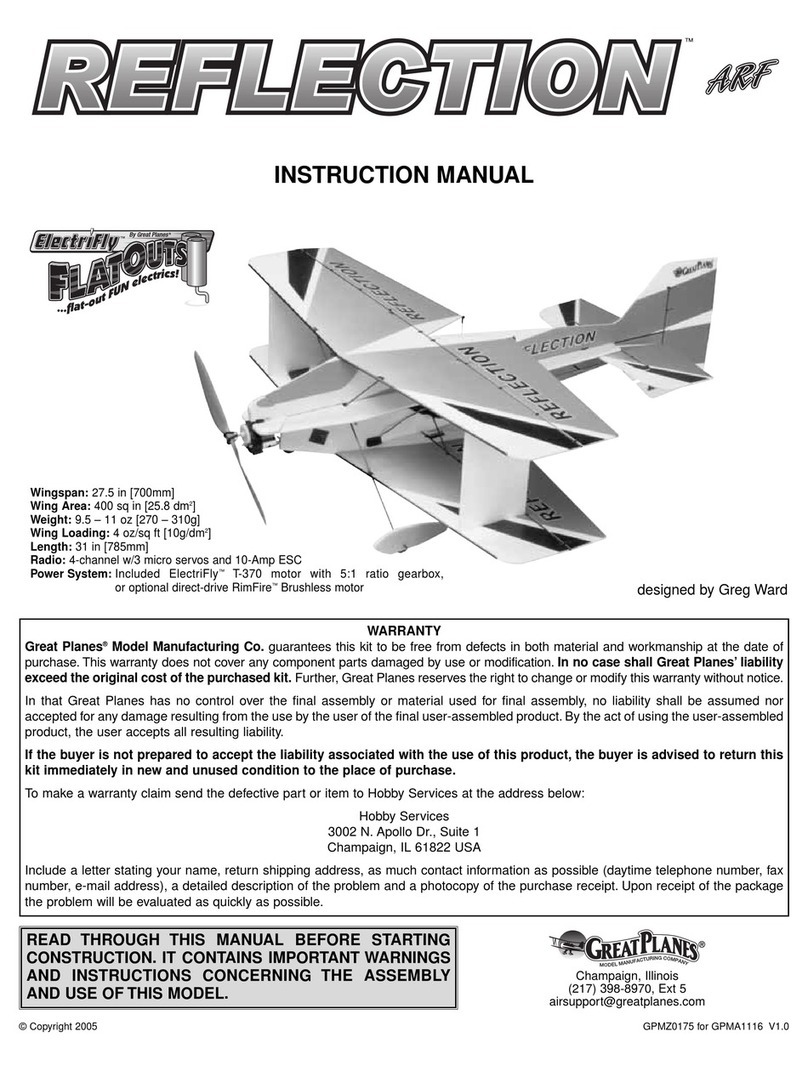
electrifly
electrifly reflection User manual
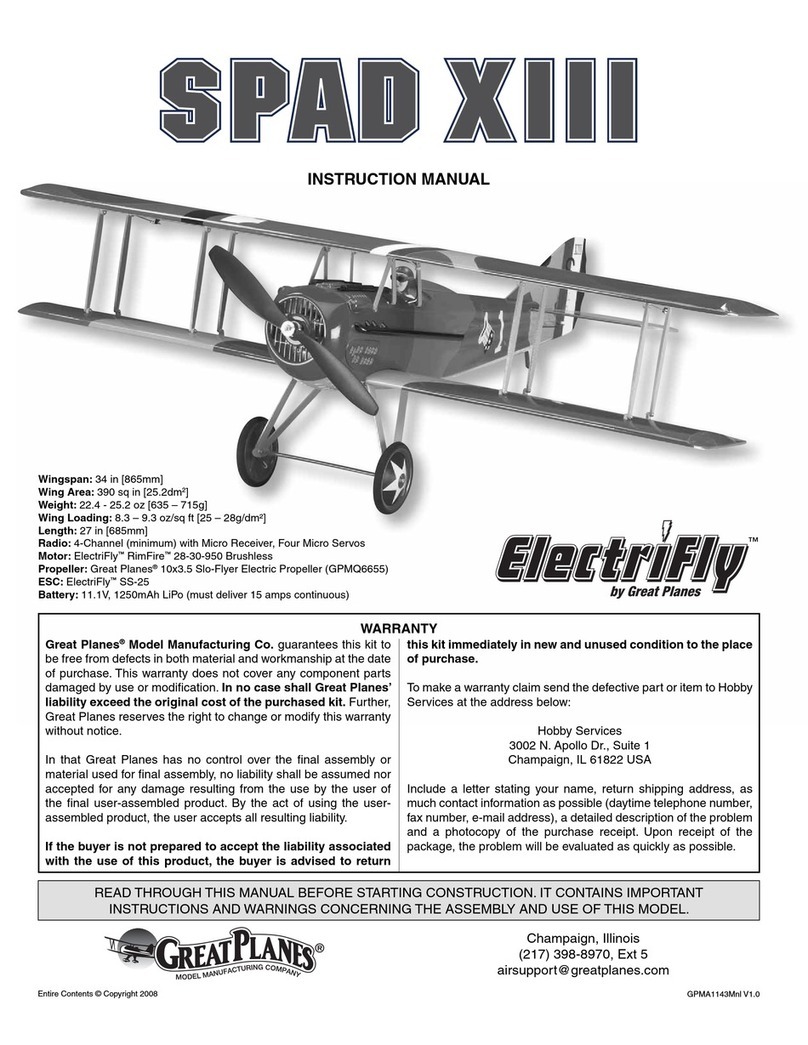
electrifly
electrifly Spad XIII User manual
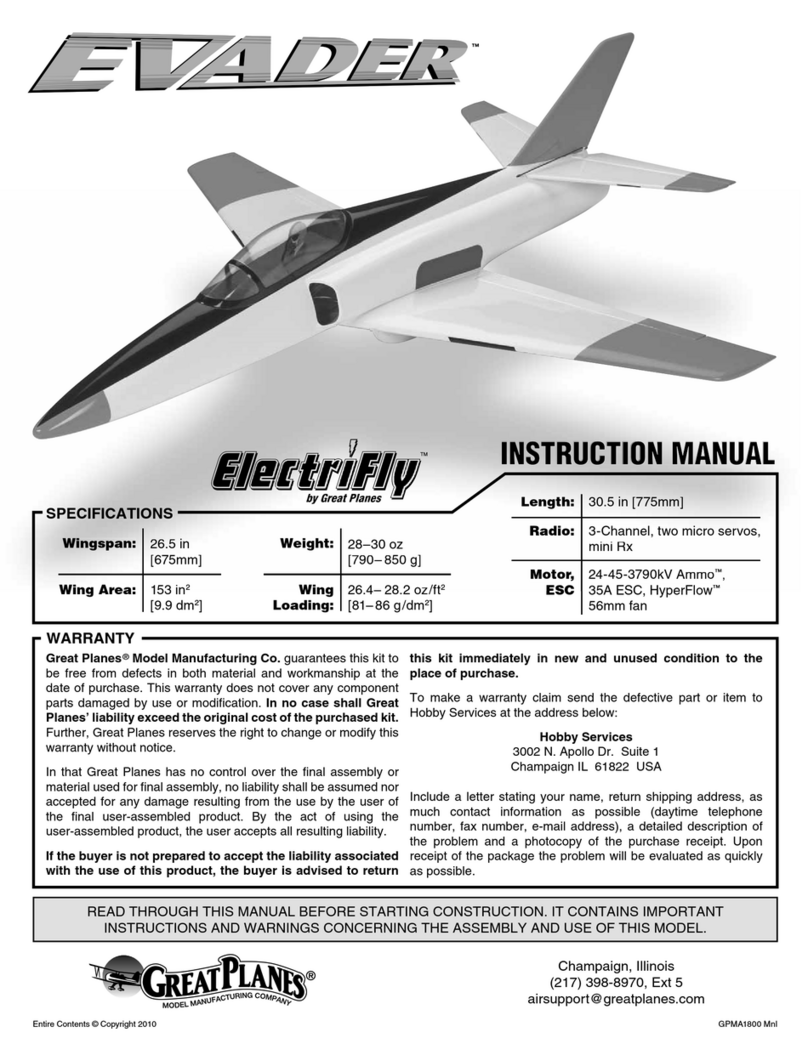
electrifly
electrifly ElectriFly User manual
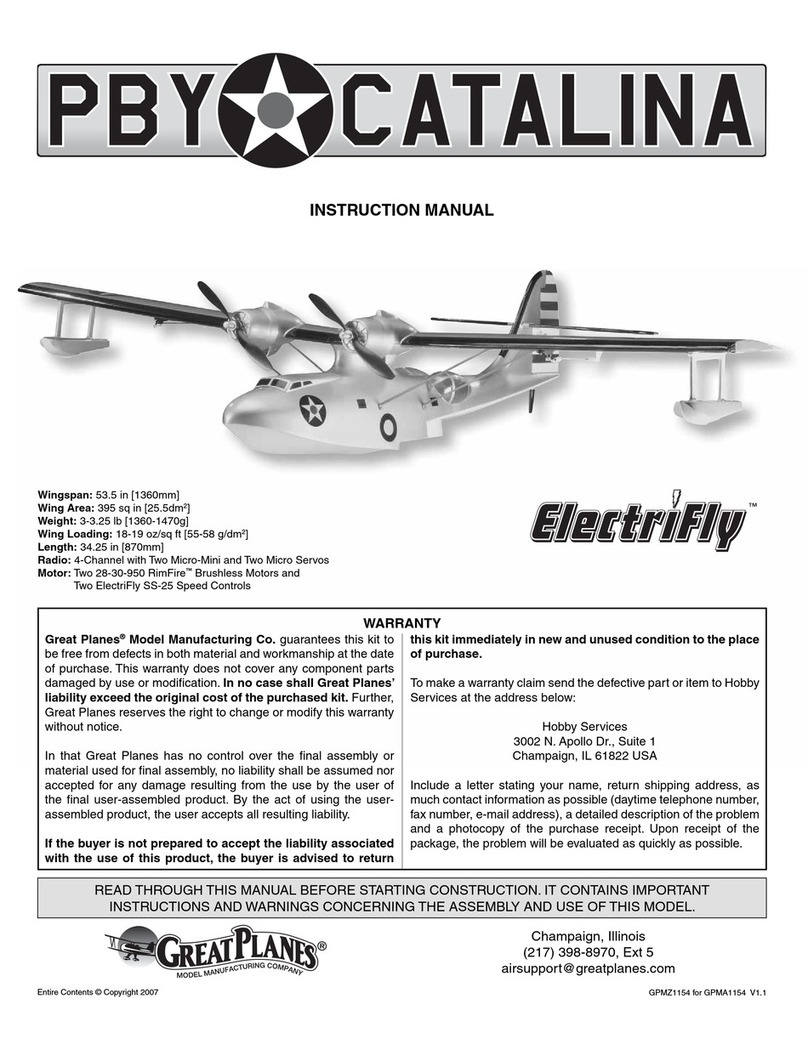
electrifly
electrifly PBY CATALINA User manual
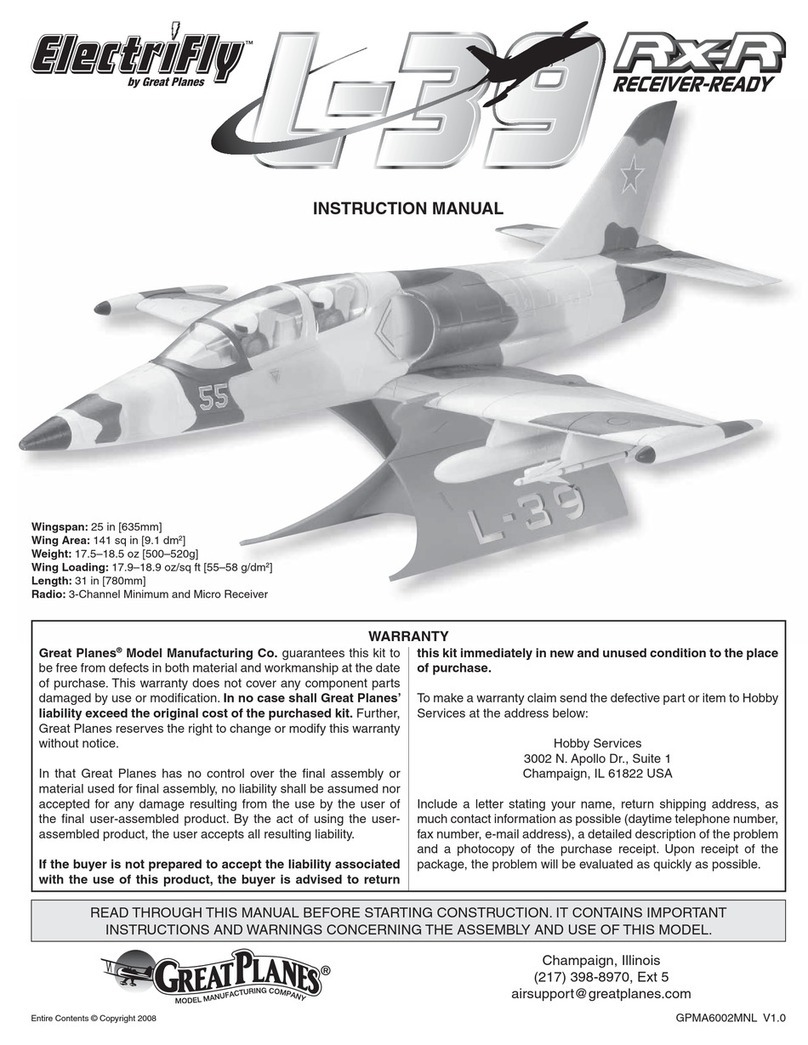
electrifly
electrifly L-39 User manual

electrifly
electrifly Super Sportster RX-R User manual
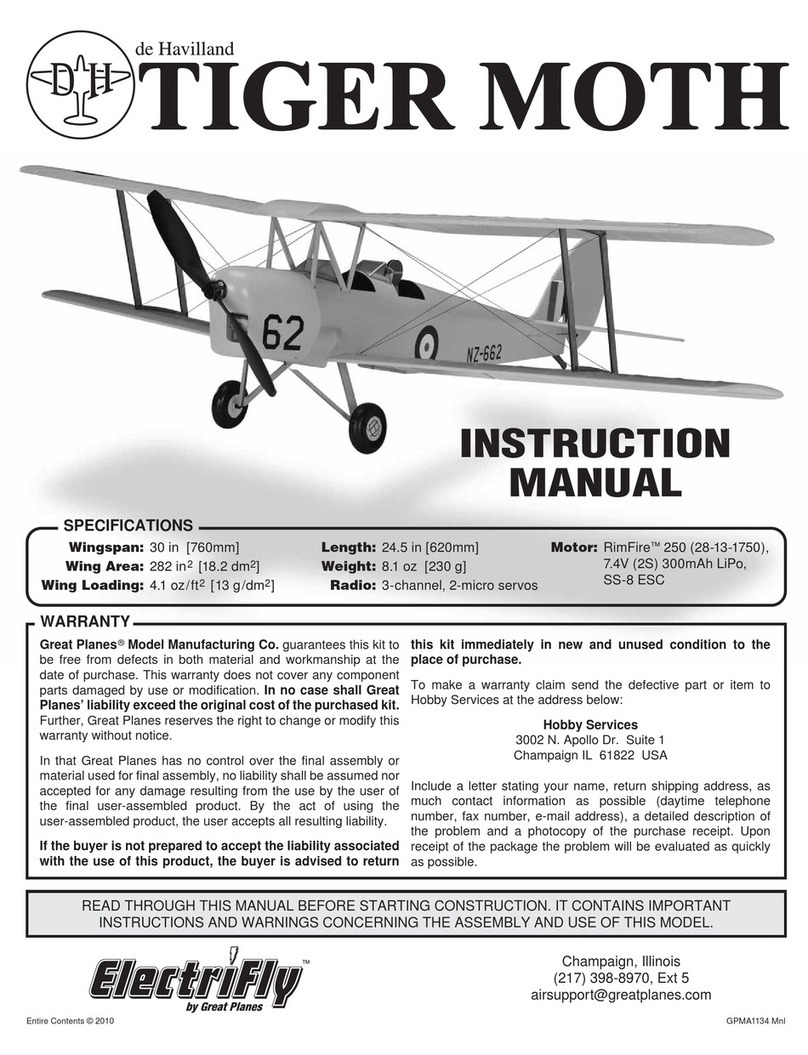
electrifly
electrifly Tiger Moth User manual


